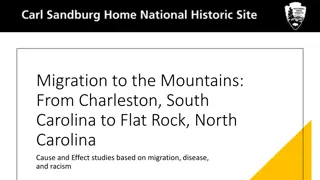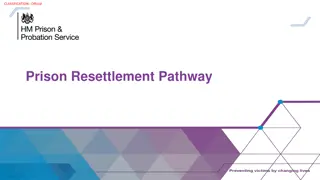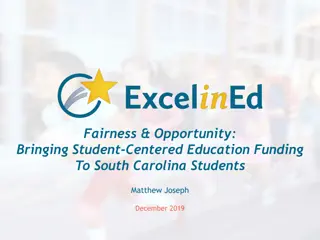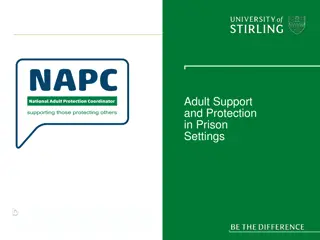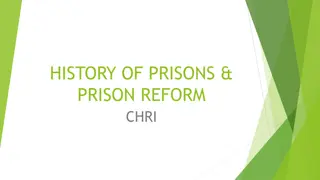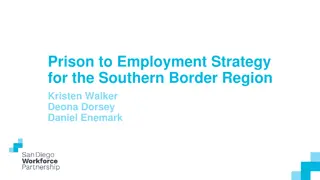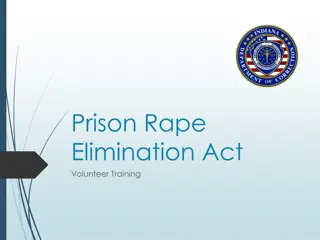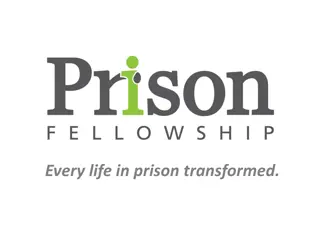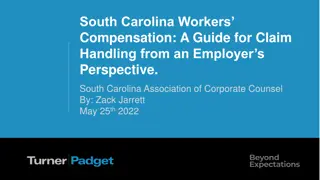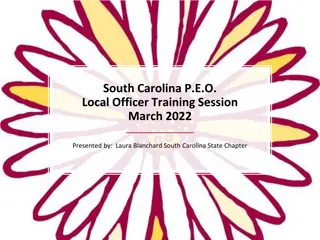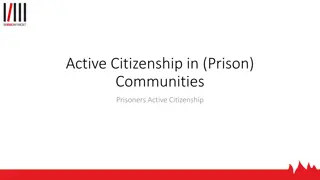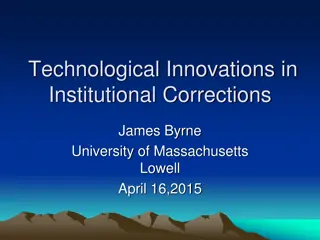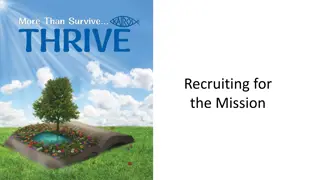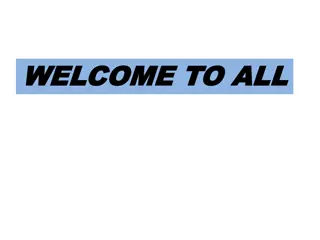Comprehensive Overview of Prison Sentences in South Carolina
The overview covers key aspects of prison sentences in South Carolina, including the classification of institutions, jurisdiction of the South Carolina Department of Corrections, categories of adult sentences, good time credit provisions, and distinctions between violent and no parole offenses.
Uploaded on Jul 30, 2024 | 0 Views
Download Presentation

Please find below an Image/Link to download the presentation.
The content on the website is provided AS IS for your information and personal use only. It may not be sold, licensed, or shared on other websites without obtaining consent from the author.If you encounter any issues during the download, it is possible that the publisher has removed the file from their server.
You are allowed to download the files provided on this website for personal or commercial use, subject to the condition that they are used lawfully. All files are the property of their respective owners.
The content on the website is provided AS IS for your information and personal use only. It may not be sold, licensed, or shared on other websites without obtaining consent from the author.
E N D
Presentation Transcript
BRIEF OVERVIEW OF PRISON SENTENCES Christina Catoe Bigelow Deputy General Counsel South Carolina Department of Corrections (803) 896-1738 bigelow.christina@doc.sc.gov
Basic Background Info about SCDC SCDC currently has 21 institutions Categorized into 4 security levels Level 3 - high Level 2 - medium Level 1-B - minimum Level 1-A pre-release work centers
Jurisdiction of SCDC Per S.C. Code 24-3-20 (A), a person sentenced to more than three months comes to SCDC. If sentence is less than three months, it must be served at the county detention center. Per S.C. Code 24-3-30 (A), SCDC, not a judge, has authority to determine how to classify an inmate and where to house the inmate.
Three Categories of Adult Sentences Parolable sentences earn the most amount of good time and work/education credits 20 days GT and average 10.86 EWC per month No parole or 85% sentences earn much less credit 3 days GT per month and max 6 days of EWC per month Day for day or mandatory minimum sentences no credits to reduce the service time sentence is served day-for-day
Good Time Credit S.C. Code 24-13-210 Parolable offenses 20 days earned per month No parole (85%) offenses 3 days per month Day-for-day (mandatory minimum) sentences - no good time available
Earned Work and Education Credits S.C. Code 24-13-230 Parolable offenses maximum yearly 180 days average 10.86 days of credit per month for 5-day per week job No parole (85%) offenses maximum yearly 72 days 6 days per month Day-for-day (mandatory minimum) offenses no work or education credits available
Violent vs. No Parole (85%) Violent offenses are defined by S.C. Code 16-1-60 No parole or 85% offenses are defined by S.C. Code 24-13-100 An 85% offense is usually also a violent offense, but not always: Example: Trafficking crack 10-28 grams, 1stoffense Violent because listed in S.C. Code 16-1-60 But not 85% because only carries 3-10 years
Maxout date vs. Parole Eligibility Date Maxout (release) date: Calculated based upon incarcerative sentence only Date when sentence is satified (expired) May or may not be followed by supervision in the community Parole eligibility date: Calculated based upon total sentence, not just incarcerative portion Earliest opportunity for release go before the parole board If paroled, offender continues to serve his or her sentence in the community under supervision by the Department of Probation, Pardon & Parole Services ( PPP )
Additional Notes on Parole Eligibility Violent (but not 85%) offenders eligible after serving one-third of sentence Non-violent offenders eligible after one-fourth of sentence Work credits can be used to shorten the parole eligibility date Subsequent violent offenders per statute, not eligible for parole if serving a sentence for a violent offense and had a prior violent offense under S.C. Code 16-1-60
Supervision After Release Parole for regular parolable offenses Community Supervision Program for 85% offenders Supervised Furlough (mostly a relic of the past - 1983-1993) Supervised Reentry S.C. Code 24-21-32
THE YOUTHFUL OFFENDER ACT S.C. Code 24-19-5 et seq. Generally for offenders age 17 to 25 at time of conviction No violent crimes except burglary second degree violent, which requires 3- year day-for-day sentence, and criminal sexual conduct with a minor in the third degree where victim was over age 14 and act was consensual No 85% offenses Only one bite at the YOA apple
Powers of the Court Upon Conviction of a Youthful Offender Generally one of two things happen: Impose a YOA sentence, but suspend it to probation probation means adult probation with PPP Impose an active YOA sentence not to exceed 6 years Per Craft v. State, if the adult maximum sentence is less than 6 years, the adult maximum controls. Example: possession of heroin carries a max of 2 years
After Intake is Complete SCDC s youthful offender division uses our internal mandatory minimum guidelines to assign the youthful offender to a term of programming. Generally 6 months, 9 months, 18 months, or three-year mandatory minimum for burglary second degree After serving the assigned term, the youthful offender is conditionally released to YOA parole ( intensive supervision ) for a period of one year If offender is non-compliant, per statute, SCDC can keep a youthful offender up to 4 years in our discretion. Such an offender must be conditionally released at the 4-year mark. Jail time is applied to back up the entire statutory period, EXCEPT for three-year day-for-day sentences we apply the jail time to reduce the three-year period. Example: for PWID cocaine: offender receives a 6-month term. Offender comes to intake for about a month and then begins his 6-month term. Any jail time credit would reduce the entire statutory period we have jurisdiction over the offender, but would not be applied to reduce the 6-month programming term.
Violations of Conditional Release An offender who violates the terms of conditional release (also called YOA parole or intensive supervision) can be returned to SCDC custody any time before expiration of the 6-year statutory period we have jurisdiction over the offender An offender accused of a violation has the opportunity to appear before an panel (comprised of three SCDC officials) for an administrative review The panel decides whether to revoke the conditional release and return the offender to custody or continue the offender on conditional release
Unconditional Discharge Complete release from our custody and supervision in the community Usually occurs well before the 6-year period for compliant offenders A youthful offender CAN be unconditionally discharged one year after being conditionally released. A youthful offender MUST be unconditionally discharged six years from the sentence start date (backed up by any jail time credit). Probationary sentences that are later activated: six-year total period still begins on sentence start date (minus jail time credit).
Expungement of YOA Sentences If a youthful offender has no other convictions in the five-year period following unconditional discharge, the offender can apply for expungement of the YOA sentence. Application for expungement is considered by a circuit court judge and is completely discretionary S.C. Code 22-5-920 (B)(2)(b) specifically prohibits violent offenses from being expunged, so a YOA sentence for burglary second violent cannot be expunged
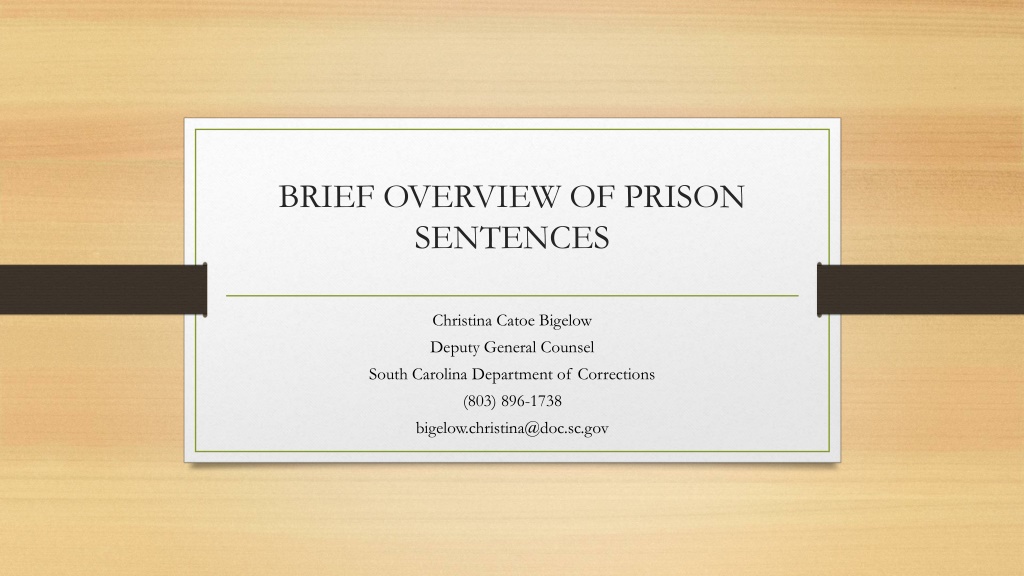
 undefined
undefined



